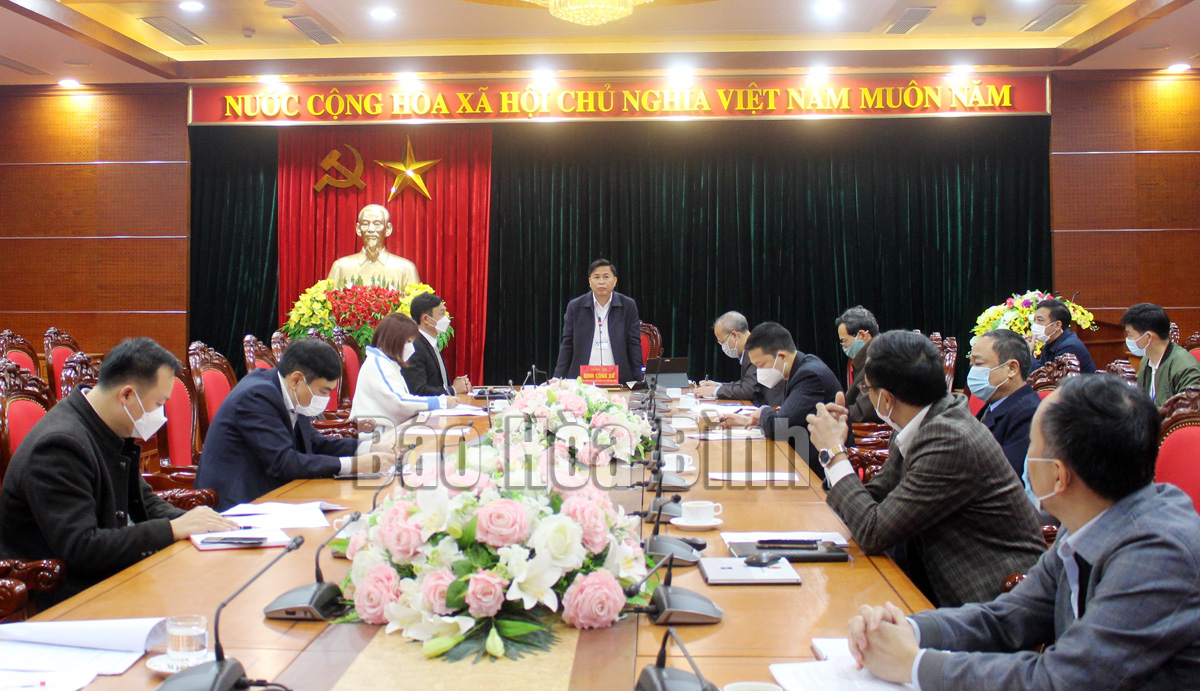
(HBO) – The Hoa Binh provincial Steering Committee on Collective Economic Development on January 10 held a teleconference reviewing its 2021 activities. Vice-Chairman of the provincial People’s Committee and its head Dinh Cong Su chaired the event.
Photo: Vice Chairman of the provincial People’s Committee and head of the provincial Steering Committee on Collective Economic Development concludes the event.
As of December 31, 2021, the province was home to 454 cooperatives, up 7.5 percent annually; four people’s credit funds and 211 cooperative teams, up 6.5 percent. Last year, 67 new cooperatives were established, up 3.08 percent annually and 18 cooperative teams, up 20 percent. Two representative offices of the Vietnam Cooperative Union are managing markets in the province. Collective economic organisations attracted 15,200 members and 26,000 workers. Average revenue and profit of each cooperative reached 2.23 billion VND and 250 million VND, respectively while average income of workers stood at 4.16 million VND each month per person. In cooperative teams, their revenue averaged 220.14 million VND each and profit at 56.5 million VND. The gap between revenue and expenditure of people’s credit funds reached 5.73 billion VND. The total profit of collective economic organisations hit 132.37 billion VND, or 0.24 percent of the added value and 0.43 percent of the province’s gross regional domestic product. Revenue to the State budget was estimated at 5.083 trillion VND, equivalent to 0.1 percent of the province’s State budget collection. This year, the steering committee set 12 targets.
Speaking at the event, Vice Chairman Su stressed that in order to fulfil 2022 targets, the steering committees on collective economic development at the provincial and district level need to continue following the Party’s guidelines and State laws and policies on collective economy, disseminating policies and legal documents and improving the capacity of workforce in cooperatives. Further attention must be paid to the implementation of policies on support and incentives for cooperatives in line with the Government’s Decree No.193/2013/ND-CP dated November 21, 2013 regulating in details several articles of the Cooperatives Law, the strengthening of State management on collective economy, and pooling the involvement of social forces and mass organisations at home and abroad for the effort./.
According to data from the Hoa Binh Provincial Party Committee, the industrial production index for the first six months of 2025 is estimated to have increased by 20% compared to the same period last year. This marks the highest year-on-year growth rate for this period since 2020.
In the first six months of 2025, Hoa Binh province’s export turnover was estimated at 1.145 billion USD, marking an 18.11% increase compared to the same period in 2024. Import turnover was estimated at $ 804 million, a 17.15% increase, which helped the province maintain a positive trade balance.
The lives of the ethnic minority farmers in Tan Lac district have gradually improved thanks to the new directions in agricultural production. This is a testament to the collective strength fostered through the professional associations and groups implemented by various levels of the district’s Farmers’ Union.
With the motto the "product quality comes first,” after nearly one year of establishment and operation, Muong village’s Clean Food Agricultural and Commercial Cooperative, located in Cau Hamlet, Hung Son Commune (Kim Boi district), has launched reputable, high-quality agricultural products to the market that are well-received by consumers. The products such as Muong village’s pork sausage, salt-cured chicken, and salt-cured pork hocks have gradually carved out a place in the market and they are on the path to obtaining the OCOP certification.
In the past, the phrase "bumper harvest, rock-bottom prices" was a familiar refrain for Vietnamese farmers engaged in fragmented, small-scale agriculture. But today, a new spirit is emerging across rural areas of Hoa Binh province - one of collaboration, organisation, and collective economic models that provide a stable foundation for production.
Maintaining growing area codes and packing facility codes in accordance with regulations is a mandatory requirement for agricultural products to be eligible for export. Recently, the Department of Agriculture and Environment of Hoa Binh province has intensified technical supervision of designated farming areas and packing facilities to safeguard the "green passport" that enables its products to access international markets.



